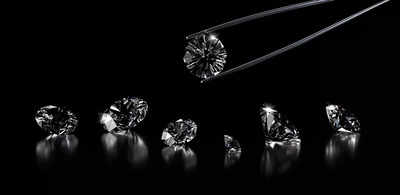Trending
This story is from September 1, 2023
How to spot a real diamond?
Here are some easy ways to spot a real diamond from a fake one.

Diamonds are renowned for their beauty, rarity, and enduring appeal, which contribute to their high price tag. Spotting a real diamond from a fake or a lesser quality stone can be a challenge, but there are several methods you can use to help determine if a diamond is genuine. Diamonds are valued for their rarity, brilliance, and durability, so it's essential to be able to identify them accurately.Here are some tips to help you spot a real diamond:
Certification and Documentation: The most reliable way to verify the authenticity of a diamond is to ask for certification from a recognized gemological laboratory. The Gemological Institute of America (GIA) and the International Gemological Institute (IGI) are reputable organizations that grade and certify diamonds.
The 4Cs: Familiarize yourself with the 4Cs of diamond grading: Cut, Color, Clarity, and Carat weight. A genuine diamond's 4Cs will be evaluated by experts and documented in its certification.
Use of a Loupe: A jeweler's loupe, a magnifying glass with 10x magnification, can help you examine the diamond's features closely. Look for small imperfections, known as inclusions, which are typically present in natural diamonds.
Fog Test: Breathe on the diamond as you would on a mirror. A real diamond will not retain the moisture and will clear up immediately. A fake diamond might remain foggy for a longer time due to its heat-conducting properties.
Heat Conductivity: Diamonds are excellent heat conductors. Hold the diamond and a glass or cubic zirconia (common diamond simulant) in your hand for a while. Touch them both to your lips. The real diamond will feel cold due to its heat conductivity, while the fake stone will not.
UV Light Test: Some diamonds emit a blue fluorescence when exposed to UV light. While this is not a definitive test, it can provide additional information about the stone's authenticity.
Water Test: Drop the diamond into a glass of water. A real diamond should sink to the bottom due to its high density. Some fakes might float or sink slowly.
Black Light Test: Under a black light, real diamonds might exhibit a blue fluorescence. However, not all real diamonds will react this way, and fluorescence can vary.
Sparkle and Brilliance: Authentic diamonds have a unique sparkle and brilliance due to their ability to reflect and refract light. Place the diamond under bright light and observe the way it scatters light.
Setting and Mounting: High-quality diamonds are usually set in high-quality metals, such as platinum or gold. Examine the setting and craftsmanship of the piece. Real diamonds are set with precision, and prongs are often uniform.
Too Good to Be True: If the price seems too good to be true, it probably is. Diamonds have a certain market value, and exceptionally low prices could indicate a fake or lesser-quality stone.
Certification and Documentation: The most reliable way to verify the authenticity of a diamond is to ask for certification from a recognized gemological laboratory. The Gemological Institute of America (GIA) and the International Gemological Institute (IGI) are reputable organizations that grade and certify diamonds.
The 4Cs: Familiarize yourself with the 4Cs of diamond grading: Cut, Color, Clarity, and Carat weight. A genuine diamond's 4Cs will be evaluated by experts and documented in its certification.
Use of a Loupe: A jeweler's loupe, a magnifying glass with 10x magnification, can help you examine the diamond's features closely. Look for small imperfections, known as inclusions, which are typically present in natural diamonds.
Refraction Test: Place the diamond on a piece of newspaper with text. A real diamond will refract light in a way that the text is not visible through the stone due to its high refractive index.
Fog Test: Breathe on the diamond as you would on a mirror. A real diamond will not retain the moisture and will clear up immediately. A fake diamond might remain foggy for a longer time due to its heat-conducting properties.
Heat Conductivity: Diamonds are excellent heat conductors. Hold the diamond and a glass or cubic zirconia (common diamond simulant) in your hand for a while. Touch them both to your lips. The real diamond will feel cold due to its heat conductivity, while the fake stone will not.
UV Light Test: Some diamonds emit a blue fluorescence when exposed to UV light. While this is not a definitive test, it can provide additional information about the stone's authenticity.
Water Test: Drop the diamond into a glass of water. A real diamond should sink to the bottom due to its high density. Some fakes might float or sink slowly.
Black Light Test: Under a black light, real diamonds might exhibit a blue fluorescence. However, not all real diamonds will react this way, and fluorescence can vary.
Sparkle and Brilliance: Authentic diamonds have a unique sparkle and brilliance due to their ability to reflect and refract light. Place the diamond under bright light and observe the way it scatters light.
Setting and Mounting: High-quality diamonds are usually set in high-quality metals, such as platinum or gold. Examine the setting and craftsmanship of the piece. Real diamonds are set with precision, and prongs are often uniform.
Too Good to Be True: If the price seems too good to be true, it probably is. Diamonds have a certain market value, and exceptionally low prices could indicate a fake or lesser-quality stone.
End of Article
FOLLOW US ON SOCIAL MEDIA









